
The Charge Of The Light Brigade
Far from the seas he will one day roam, half Cherokee and one quarter Creek Indian (his white paternal grandfather marries a Creek woman to gain access to her land, mission accomplished, he then divorces the woman and disowns his son), Evans is born on 8/13/1908 in Pawnee, Oklahoma, with warrior blood running through his veins. Battling prejudice in a time not far removed from Indians being the nation's number one boogie-man, Evans graduates from the all-white Muskogee Central High School, joins the Oklahoma National Guard, and then transfers from there into the United States Navy. Quickly recognized for his intelligence, determination, and leadership capabilities, without the normal political pull, he wins an appointment to the United States Naval Academy at Annapolis, Maryland, and graduates with the class of 1931 (a class that will produce three Congressional Medal-of-Honor winners) ... and while there of course, he gets the nickname that will be his until his death, "Chief."

Evans At Annapolis
Graduated, Ensign Evans is first assigned to the battleship USS Colorado as part of the Pacific fleet stationed at San Diego, California. In the years before WWII, in various capacities, Evans will serve on the destroyers USS Roper and USS Rathburne, the light cruiser USS Pensacola, the transport USS Chaumont, and on the destroyer tender, USS Black Hawk (he also finds time to get married and have two sons). When the Japanese attack Pearl Harbor, he is the executive officer aboard the WWI destroyer, USS Alden, stationed in the Far East (in 1942 he will be made the ship's skipper). Luck shown early, by the time the USS Alden arrives in Singapore to support the British battleship HMS Prince of Wales and the battlecruiser HMS Repulse in their attempt to stop the Japanese invasion of Malaya, Force Z has already left port ... the USS Alden is only in time to pick up survivors of the double sinking that takes place on 12/10/1941.

Prince of Wales (Front) & Repulse Under Attack
On 2/27/1942, the USS Alden is present at another naval debacle, the Battle of the Java Sea in which a Japanese fleet sinks two heavy cruisers, 3 destroyers, and damages a heavy cruiser at the cost of one destroyer being damaged and thirty-six Japanese sailors losing their lives. Ordered to break off from the one-sided clash, the USS Alden insures there are survivors by covering the retreat by laying down walls of smoke from his destroyer's ancient stacks. Alive, but not happy (he will win a Bronze star during this period for the depth charge attack he orchestrates against a mine laying Japanese submarine), Evans vows never to run from the Japanese again ... a pledge he tells all who will listen ... including the Seattle, Washington crowd that is on hand in 1943 to celebrate the launching of Evans' new command, the Fletcher-class destroyer, USS Johnston (using John Paul Jones's words, he tells all that he intends to take the USS Johnston "... in harm's way).

HMS Exeter Sinking - The Battle Of The Java Sea
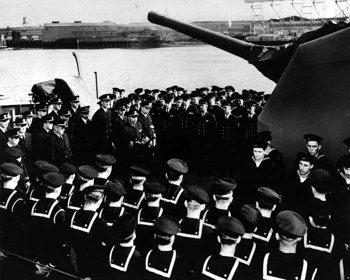
Commissioning Ceremony - 1943
The destroyer Evans receives from the Seattle-Tacoma Shipbuilding Corporation is 376 feet and 6 inches long, has a beam of 39 feet and 8 inches, a draft 17 feet and 9 inches, is propelled by two steam turbines that can produce 35 knots of speed, and is armed with five 5-inch guns, ten 40mm AA guns, seven 20mm guns, depth charges, and torpedoes. Placed into immediate service in the war raging over the waters of the Pacific, the USS Johnston fires on the beaches of Kwajalein on 2/1/1944 before the Marines storm ashore, bombards the island of Eniwetok for five days prior to its invasion, sinks the Japanese submarine I-176 on 5/15/1944, sends more than 4,000 shells into Guam before its invasion, provides escort carrier protection during the invasion of Peleliu, and on 10/25/1945, the USS Johnston is protecting the escort carriers of Taffy-3 (a support group under the command of Rear Admiral Clifton A. F. "Ziggy" Sprague consisting of six slow, and lightly armored escort carriers, three destroyers, and four destroyer-escorts) during the invasion of Leyte island in the Philippines.

The USS Johnston
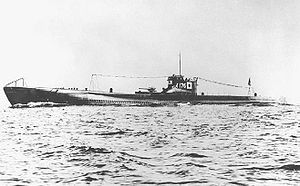
I-176

Sprague
Expecting a normal day, the USS Johnston is the northern-most ship circling the escort carriers when the unexpected call goes up, "Enemy ships approaching!" Enemy ships indeed, coming over the northern horizons are the pagoda masts of a Japanese battle fleet under the command of Admiral Takeo Kurita that consists of four battleships, six heavy cruisers, two light cruisers, and eleven destroyers ... ships that are faster, more heavily armored and armed, and that in the case of the battleship Yamato (by contrast to the USS Johnston, the Japanese battleship is 862 feet and 11 inches long), can send high-explosive or armor piercing shells to targets up to twenty-six miles away. Disaster looming (because Admiral "Bull" Halsey has mistaken left San Bernadino Strait open while he pursues four Japanese carriers to the north), before any orders can be given, Evans reacts by ordering his ship hard to port, tells the engine room to begin laying down a smoke screen, and charges the twenty-three ships of Kurita ... knowing the USS Johnston is alone and must cover miles of open ocean to get close enough to use his 5-inch guns or torpedoes.
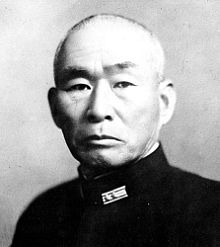
Kurita

Yamato - 1941
Zig-zagging forward by chasing the colorful splashes of Japanese rounds (the rounds of each Japanese ship include a variety of pastel colored dyes in the shells for improved adjusted aiming) that miss the USS Johnston (passing overhead, some of the sixteen inch shells that miss the destroyer are described as sounding like a freight train going by a full speed), without being hit, the USS Johnston gets close enough to Kurita's fleet to score 5-inch hits on the leading heavy cruisers (during this part of the fight the USS Johnston will more than 200 rounds at the Japanese) and to launch her full compliment of ten torpedoes from their maximum range of 9,000 yards ... two blow off the bow of the heavy cruiser Kumano, several miss the battleship Kongo, but force her to change course and turn away from her attack, and the heavy cruiser Suzuya turns away to assist the Kumano. Confused by air attacks, smoke, the sea covered in shell splashes, and the weariness of being under almost constant attack the day before, Kurita believes he is in a duel with several heavy cruisers, not a single destroyer.
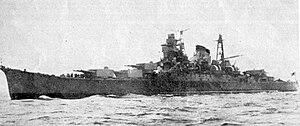
Kumano

Suzuya

The USS Johnston Attacks
Under cover of his smoke screen, Evans reverses course and tries to put distance between himself and the still advancing Japanese ... but ship's luck comes to an end at around 7:30 in the morning, when from a distance of over eight miles, Evans' ship is first hit by shells from the Kongo that cause the destroyer to only be able to operate at half speed, and a deadly salvo from the Yamato that hits the ships bridge area, mangling the men and equipment operating there, including Evans who has his body peppered by shrapnel, loses two fingers off his left hand, and his helmet and shirt portion of his uniform is blown off. And once more, the warrior soul of the man is exposed ... wrapping a handkerchief around his bleeding hand, Evans tells the ship's doctor, "Don't bother me now. Help some of those guys who are hurt," then he finds a position among his mangled ship with an open hatch where he can yell down course changes to the men now maneuvering the ship from its fantail. Incredible, and Evans isn't done!
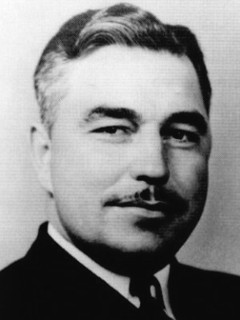
Evans
The other destroyers and escort destroyers of Taffy 3 by now ordered to launch their own torpedo attacks on Kurita, bare chested and covered in blood, Evans salutes the Samuel B. Roberts as that ship goes by on its torpedo run ... then he orders the USS Johnston into a rain squall where they are protected long enough to do some quick emergency repairs, once more calls for a reverse of course and moves towards the Japanese in support of the torpedo runs of the other Taffy 3 escorts, firing all her still operational guns (surprised suddenly by the presence of the USS Johnston, the destroyer USS Heerman mixes colliding with her sister ship by only ten feet) ... and for her next opponent, she chooses the Kongo, getting so close to the huge battleship that the Japanese guns can't suppress enough to target the pesky destroyer ... a temporary advantage that the USS Johnston uses to shoot up the bridge area of Kongo (of the 40 rounds sent Kongo's way, at least 15 hit the vulnerable bridge area) before disappearing into the smoke.

USS Heermann

Kongo
Informed that cruisers are about to attack the escort carrier Gambier Bay, Evans closes on the heavy cruiser Haguro, and duels with the vessel for over ten minutes, giving and receiving hits. That crisis taken care of for the moment, Evans then reverses course once more and goes after a column of Japanese destroyers closing on the escort carriers, crossing the "T," one ship against seven Japanese destroyers ... and the incredible day of the USS Johnston and her commander continues. The first ship in the Japanese line is hit a dozen times and veers away, the next ship up is hit five times, and it veers away ... and to avoid more fire from the USS Johnston, the whole column turns west, away from the escort carriers ... so far away that when they do launch their torpedoes at Taffy 3, each one is a miss.

USS Gambier Bay

Haguro
Fighting for over two hours, continuing to fire on its opponents, the USS Johnston is eventually by four cruisers and a number of destroyers which finally cause the ship to go dead in the water until finally, at around 9:40 in the morning, Evans gives the order to abandon his sinking ship. Twenty-five minutes later, the valiant USS Johnston goes under the waves of the Philippine off Samar Island ... a death not in vain for the 186 of her sailors that never get back to their homes in America because Admiral Kurita, confused and tired of the beating his ships have been taking, at the moment when he can sink the rest of Taffy 3 and shoot up the American landing beaches, orders his fleet to reverse course and retreat back to its base at Brunei. Evans and the USS Johnston, along with the other destroyers and destroyer escorts have turned absolute and certain defeat into one of the greatest moments in United States naval history.

USS Samuel B. Roberts

USS Hoel
And the honors for the commander and ship that gave its all begin immediately ... expecting to be machine-gunned in the water, the survivors of the USS Johnston are instead acknowledged as respected warriors by a host of Japanese sailors passing by chanting "SAMURAI" to the men below, and a destroyer captain raises a salute as to the men in the water as he heads north. Sadly, though Evans is seen lowering himself into the Pacific, he is not found when two days later, the surviving members of his crew are plucked out of the shark infested waters. For their deeds, the crew of the USS Johnston will be awarded a Presidential Unit Citation, and Evans will be posthumously given the Congressional Medal-of-Honor.
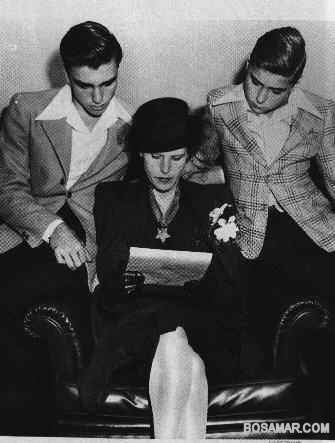
Evans' Wife And Two Sons Reading His Medal of Honor
Citation, She While Wearing His Medal
One very, very special man ... on the anniversary of his death, I'll close with the author of the Battle of Leyte Gulf, Thomas J. Cutler last words in his book describing the battle. "The causes for which these men fought and sacrificed have faded with time; the machines that were used to carry out their deadly business are now rusted relics of another era; the sands have swallowed their footprints and the waters show no trace of their wakes. But the glory of their deeds will never be tarnished by time." Amen to that ... rest in peace Commander Evans ... and thank you!

Commander Ernest Edwin Evans
This comment has been removed by the author.
ReplyDelete
ReplyDeleteThank you for an excellent insight into a great man, who because of his early death and (some say) an attempted hush campaign by supporters of Admiral Halsey, has faded from history. My father was turning the rudder to Cmdr. Evans commands on that day and spent 52 hours in the ocean (he is the sailor in front of Evans in the picture above); I couldn't be more proud!
Read a mention of Cmdr. Evans on another site and then googled him. Can't even find the words to describe how I feel. What a hero! I kinda held my breath while I was reading about what he did. What he (and his grandmother and father) had to deal with in life and then what he did while wounded. So sad that he didn't get to live those "tomorrows" with his wife and son.
ReplyDeletethis isnt even the full story if you can find the book called the battle of leyte gulf it tells you everything. Its a hard book to follow because its written using naval documents from WW2 but it tells the whole truth
ReplyDeleteThank you! The one by Edwin Hoyt or Thomas Cutler?
DeleteI actually recommend Last Stand of the Tin Can Sailors by James D. Hornfischer
Delete